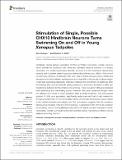Files in this item
Stimulation of single, possible CHX10 hindbrain neurons turns swimming on and off in young Xenopus tadpoles
Item metadata
| dc.contributor.author | Li, Wen-Chang | |
| dc.contributor.author | Soffe, Stephen | |
| dc.date.accessioned | 2019-02-18T09:30:08Z | |
| dc.date.available | 2019-02-18T09:30:08Z | |
| dc.date.issued | 2019-02-18 | |
| dc.identifier | 257592956 | |
| dc.identifier | c90139f5-9640-47b0-bff5-5f2d9e7fece8 | |
| dc.identifier | 85064211483 | |
| dc.identifier | 000459089300001 | |
| dc.identifier.citation | Li , W-C & Soffe , S 2019 , ' Stimulation of single, possible CHX10 hindbrain neurons turns swimming on and off in young Xenopus tadpoles ' , Frontiers in Cellular Neuroscience , vol. 13 , 47 . https://doi.org/10.3389/fncel.2019.00047 | en |
| dc.identifier.issn | 1662-5102 | |
| dc.identifier.other | ORCID: /0000-0002-1179-6636/work/64361122 | |
| dc.identifier.uri | https://hdl.handle.net/10023/17084 | |
| dc.description | Authors thank Royal Society, Wellcome Trust and BBSRC (BB/L00111X) for their support in the past. | en |
| dc.description.abstract | Vertebrate central pattern generators (CPGs) controlling locomotion contain neurons which provide the excitation that drives and maintains network rhythms. In a simple vertebrate, the developing Xenopus tadpole, we study the role of excitatory descending neurons with ipsilateral projecting axons (descending interneurons, dINs) in the control of swimming rhythms. In tadpoles with both intact central nervous system (CNS) and transections in the hindbrain, exciting some individual dINs in the caudal hindbrain region could start swimming repeatedly. Analyses indicated the recruitment of additional dINs immediately after such evoked dIN spiking and prior to swimming. Excitation of dINs can therefore be sufficient for the initiation of swimming. These “powerful” dINs all possessed both ascending and descending axons. However, their axon projection lengths were not different from those of other excitatory dINs at similar locations. The dorsoventral position of dINs, as a population, significantly better matched that of cells marked by immunocytochemistry for the transcription factor CHX10 than other known neuron types in the ventral hindbrain and spinal cord. The comparison suggests that the excitatory interneurons including dINs are CHX10-positive, in agreement with CHX10 as a marker for excitatory neurons with ipsilateral projections in the spinal cord and brainstem of other vertebrates. Overall, our results further demonstrate the key importance of dINs in driving tadpole swimming rhythms. | |
| dc.format.extent | 12 | |
| dc.format.extent | 5750155 | |
| dc.language.iso | eng | |
| dc.relation.ispartof | Frontiers in Cellular Neuroscience | en |
| dc.subject | Central pattern generator | en |
| dc.subject | Swimming | en |
| dc.subject | Excitatory interneurons | en |
| dc.subject | Spinal cord | en |
| dc.subject | Hindbrain | en |
| dc.subject | CHX10 | en |
| dc.subject | RC0321 Neuroscience. Biological psychiatry. Neuropsychiatry | en |
| dc.subject | NDAS | en |
| dc.subject.lcc | RC0321 | en |
| dc.title | Stimulation of single, possible CHX10 hindbrain neurons turns swimming on and off in young Xenopus tadpoles | en |
| dc.type | Journal article | en |
| dc.contributor.sponsor | BBSRC | en |
| dc.contributor.sponsor | The Wellcome Trust | en |
| dc.contributor.sponsor | The Royal Society | en |
| dc.contributor.institution | University of St Andrews. School of Psychology and Neuroscience | en |
| dc.contributor.institution | University of St Andrews. Institute of Behavioural and Neural Sciences | en |
| dc.identifier.doi | 10.3389/fncel.2019.00047 | |
| dc.description.status | Peer reviewed | en |
| dc.identifier.grantnumber | BB/L00111X/1 | en |
| dc.identifier.grantnumber | 089319/Z/09/Z | en |
| dc.identifier.grantnumber | UF100005 | en |
This item appears in the following Collection(s)
Items in the St Andrews Research Repository are protected by copyright, with all rights reserved, unless otherwise indicated.

